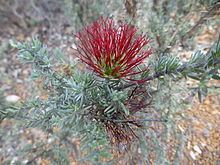Rank Species | ||
 | ||
Similar Beaufortia cyrtodonta, Beaufortia aestiva, Beaufortia orbifolia, Beaufortia schaueri, Beaufortia sparsa | ||
Beaufortia incana, commonly known as grey-leaved beaufortia is a plant in the myrtle family, Myrtaceae and is endemic to the south-west of Western Australia. It is a low, compact shrub with crowded leaves which appear whitish due to their covering of fine, soft hairs on both surfaces. It has almost spherical heads of red flowers in spring.
Contents
Description
Beaufortia incana is a compact shrub which grows to a height of 2 m (7 ft). The leaves are arranged alternately, crowded on the younger stems, linear to lance-shaped and arranged in alternate pairs (decussate) so that they make four rows along the stems. The leaves are about 6.5–10.5 mm (0.3–0.4 in) long and have a covering of fine hairs on both surfaces.
The flowers are red and are arranged in dense heads about 25 mm (1 in) in diameter on the ends of the branches and are surrounded by long soft hairs. The flowers have 5 sepals, 5 petals and 5 bundles of stamens. The stamens give the flowers their colour and are in bundles of 3, joined for most of their length, the bundles of different lengths. Flowering occurs from August to December and is followed by fruit which are woody capsules.
Taxonomy and naming
Beaufortia macrostemon var. incana was first formally described in 1867 by George Bentham in Flora Australiensis. In 1972, Alex George raised it to species status in Nuytsia. The specific epithet ("incana") is a Latin word meaning "quite gray".
Distribution and habitat
Beaufortia incana occurs in the Avon Wheatbelt, Jarrah Forest, Mallee and Swan Coastal Plain biogeographic regions. It grows in soils derived from laterite on hills and sandplains.
Conservation
Beaufortia incana is classified as "not threatened" by the Western Australian Government Department of Parks and Wildlife.
